Analysis of Cross-Cultural Management at Barclays Bank Report
VerifiedAdded on 2020/06/06
|13
|4360
|114
Report
AI Summary
This report provides an in-depth analysis of cross-cultural management practices within Barclays Bank, focusing on the differences between the organizational cultures of the United Kingdom and the European Union. The assignment explores the importance of incorporating cross-cultural interactions to facilitate effective communication and productivity within a diverse workforce of approximately 119,300 employees. It examines the impact of cultural diversity, including potential conflicts and differing opinions. The report also delves into various models and frameworks for cross-cultural dimensions, such as Hofstede, Schein, and Trompenaars, and applies Handy's and Deal and Kennedy's cultural models to Barclays Bank. It further identifies key challenges related to economic, social, and legal factors when operating in diverse cultural environments. The report assesses how Barclays can leverage these models to improve its cross-cultural management and foster a more inclusive and productive work environment. The second half of the assignment takes into consideration challenges and barriers which are encountered by teams.
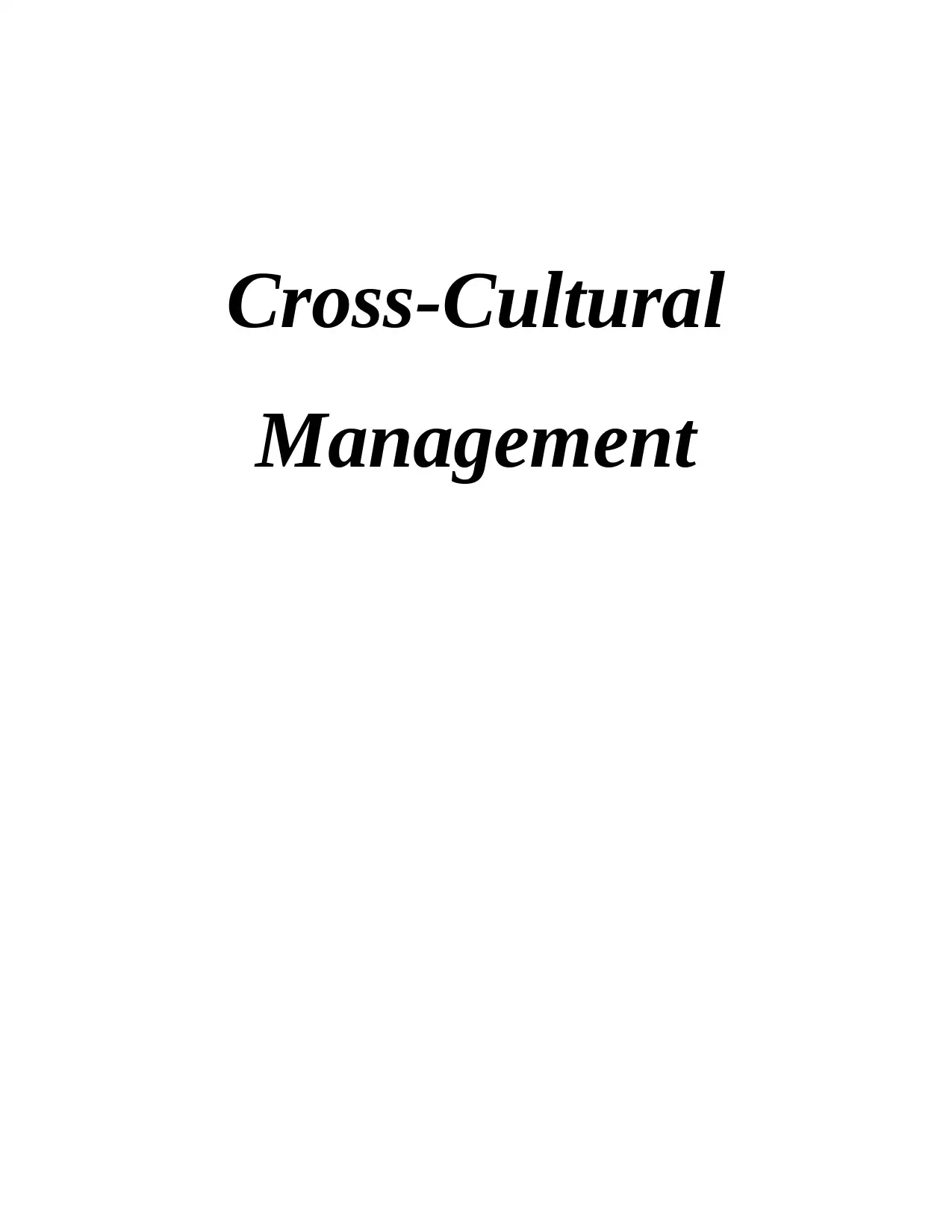
Cross-Cultural
Management
Management
Paraphrase This Document
Need a fresh take? Get an instant paraphrase of this document with our AI Paraphraser
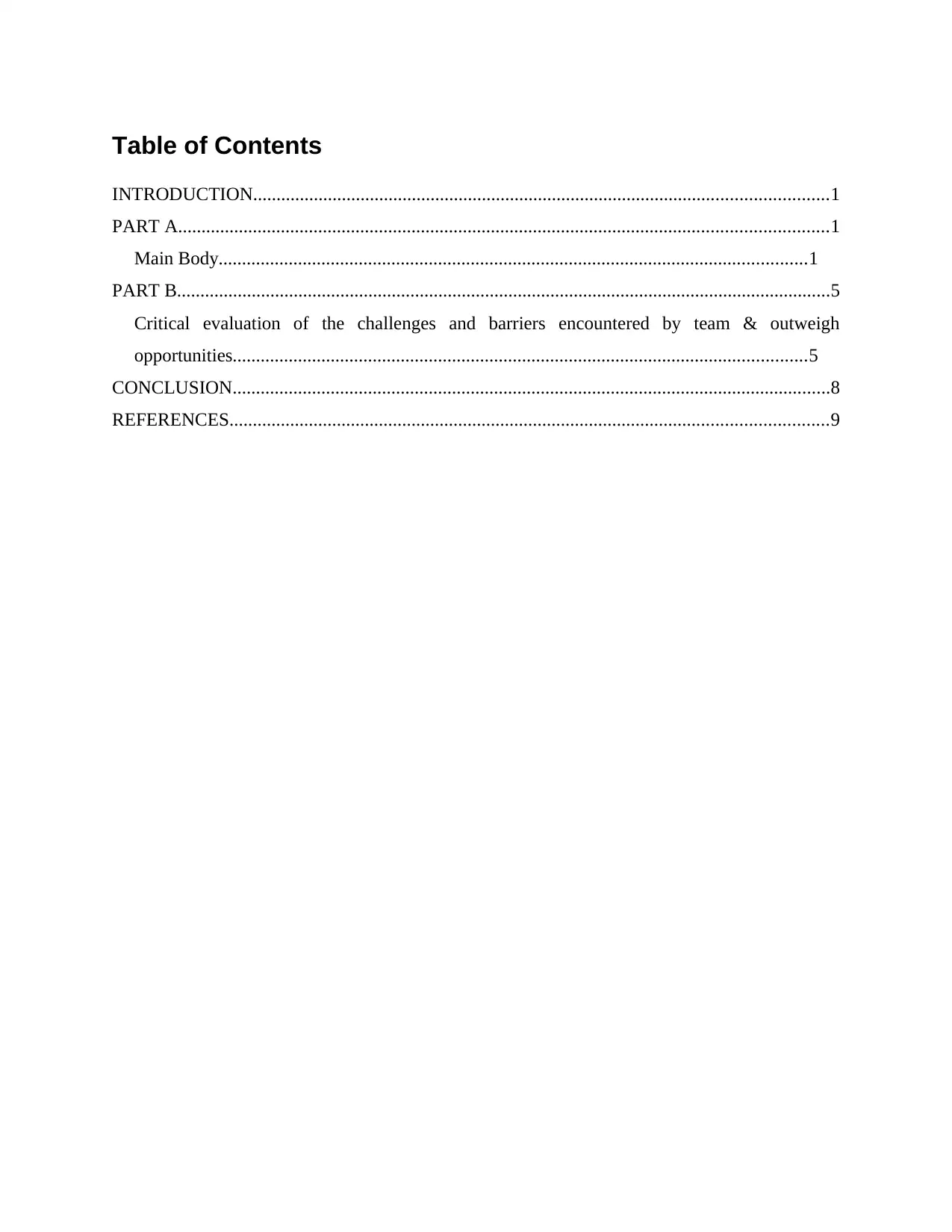
Table of Contents
INTRODUCTION...........................................................................................................................1
PART A...........................................................................................................................................1
Main Body..............................................................................................................................1
PART B............................................................................................................................................5
Critical evaluation of the challenges and barriers encountered by team & outweigh
opportunities...........................................................................................................................5
CONCLUSION................................................................................................................................8
REFERENCES................................................................................................................................9
INTRODUCTION...........................................................................................................................1
PART A...........................................................................................................................................1
Main Body..............................................................................................................................1
PART B............................................................................................................................................5
Critical evaluation of the challenges and barriers encountered by team & outweigh
opportunities...........................................................................................................................5
CONCLUSION................................................................................................................................8
REFERENCES................................................................................................................................9
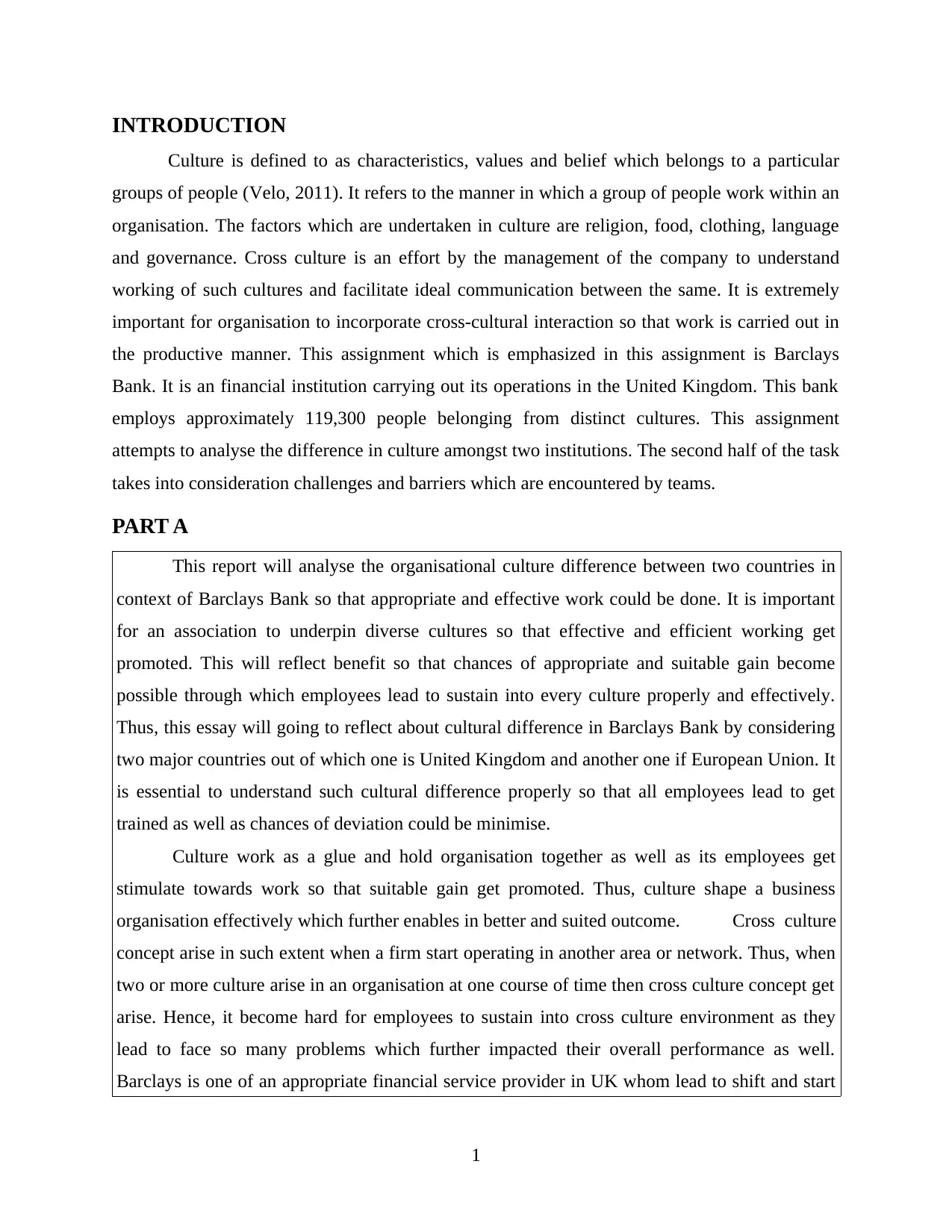
INTRODUCTION
Culture is defined to as characteristics, values and belief which belongs to a particular
groups of people (Velo, 2011). It refers to the manner in which a group of people work within an
organisation. The factors which are undertaken in culture are religion, food, clothing, language
and governance. Cross culture is an effort by the management of the company to understand
working of such cultures and facilitate ideal communication between the same. It is extremely
important for organisation to incorporate cross-cultural interaction so that work is carried out in
the productive manner. This assignment which is emphasized in this assignment is Barclays
Bank. It is an financial institution carrying out its operations in the United Kingdom. This bank
employs approximately 119,300 people belonging from distinct cultures. This assignment
attempts to analyse the difference in culture amongst two institutions. The second half of the task
takes into consideration challenges and barriers which are encountered by teams.
PART A
This report will analyse the organisational culture difference between two countries in
context of Barclays Bank so that appropriate and effective work could be done. It is important
for an association to underpin diverse cultures so that effective and efficient working get
promoted. This will reflect benefit so that chances of appropriate and suitable gain become
possible through which employees lead to sustain into every culture properly and effectively.
Thus, this essay will going to reflect about cultural difference in Barclays Bank by considering
two major countries out of which one is United Kingdom and another one if European Union. It
is essential to understand such cultural difference properly so that all employees lead to get
trained as well as chances of deviation could be minimise.
Culture work as a glue and hold organisation together as well as its employees get
stimulate towards work so that suitable gain get promoted. Thus, culture shape a business
organisation effectively which further enables in better and suited outcome. Cross culture
concept arise in such extent when a firm start operating in another area or network. Thus, when
two or more culture arise in an organisation at one course of time then cross culture concept get
arise. Hence, it become hard for employees to sustain into cross culture environment as they
lead to face so many problems which further impacted their overall performance as well.
Barclays is one of an appropriate financial service provider in UK whom lead to shift and start
1
Culture is defined to as characteristics, values and belief which belongs to a particular
groups of people (Velo, 2011). It refers to the manner in which a group of people work within an
organisation. The factors which are undertaken in culture are religion, food, clothing, language
and governance. Cross culture is an effort by the management of the company to understand
working of such cultures and facilitate ideal communication between the same. It is extremely
important for organisation to incorporate cross-cultural interaction so that work is carried out in
the productive manner. This assignment which is emphasized in this assignment is Barclays
Bank. It is an financial institution carrying out its operations in the United Kingdom. This bank
employs approximately 119,300 people belonging from distinct cultures. This assignment
attempts to analyse the difference in culture amongst two institutions. The second half of the task
takes into consideration challenges and barriers which are encountered by teams.
PART A
This report will analyse the organisational culture difference between two countries in
context of Barclays Bank so that appropriate and effective work could be done. It is important
for an association to underpin diverse cultures so that effective and efficient working get
promoted. This will reflect benefit so that chances of appropriate and suitable gain become
possible through which employees lead to sustain into every culture properly and effectively.
Thus, this essay will going to reflect about cultural difference in Barclays Bank by considering
two major countries out of which one is United Kingdom and another one if European Union. It
is essential to understand such cultural difference properly so that all employees lead to get
trained as well as chances of deviation could be minimise.
Culture work as a glue and hold organisation together as well as its employees get
stimulate towards work so that suitable gain get promoted. Thus, culture shape a business
organisation effectively which further enables in better and suited outcome. Cross culture
concept arise in such extent when a firm start operating in another area or network. Thus, when
two or more culture arise in an organisation at one course of time then cross culture concept get
arise. Hence, it become hard for employees to sustain into cross culture environment as they
lead to face so many problems which further impacted their overall performance as well.
Barclays is one of an appropriate financial service provider in UK whom lead to shift and start
1
⊘ This is a preview!⊘
Do you want full access?
Subscribe today to unlock all pages.

Trusted by 1+ million students worldwide
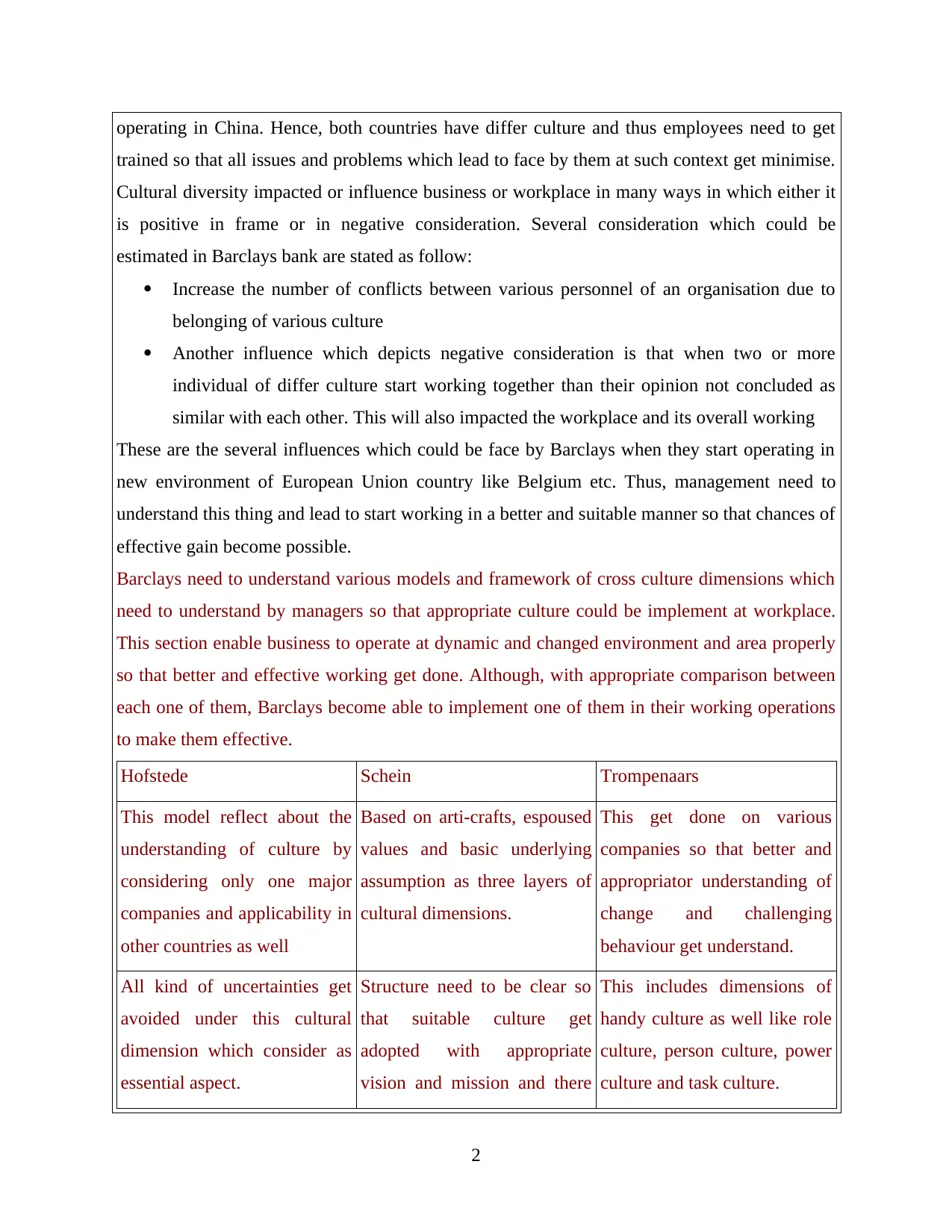
operating in China. Hence, both countries have differ culture and thus employees need to get
trained so that all issues and problems which lead to face by them at such context get minimise.
Cultural diversity impacted or influence business or workplace in many ways in which either it
is positive in frame or in negative consideration. Several consideration which could be
estimated in Barclays bank are stated as follow:
Increase the number of conflicts between various personnel of an organisation due to
belonging of various culture
Another influence which depicts negative consideration is that when two or more
individual of differ culture start working together than their opinion not concluded as
similar with each other. This will also impacted the workplace and its overall working
These are the several influences which could be face by Barclays when they start operating in
new environment of European Union country like Belgium etc. Thus, management need to
understand this thing and lead to start working in a better and suitable manner so that chances of
effective gain become possible.
Barclays need to understand various models and framework of cross culture dimensions which
need to understand by managers so that appropriate culture could be implement at workplace.
This section enable business to operate at dynamic and changed environment and area properly
so that better and effective working get done. Although, with appropriate comparison between
each one of them, Barclays become able to implement one of them in their working operations
to make them effective.
Hofstede Schein Trompenaars
This model reflect about the
understanding of culture by
considering only one major
companies and applicability in
other countries as well
Based on arti-crafts, espoused
values and basic underlying
assumption as three layers of
cultural dimensions.
This get done on various
companies so that better and
appropriator understanding of
change and challenging
behaviour get understand.
All kind of uncertainties get
avoided under this cultural
dimension which consider as
essential aspect.
Structure need to be clear so
that suitable culture get
adopted with appropriate
vision and mission and there
This includes dimensions of
handy culture as well like role
culture, person culture, power
culture and task culture.
2
trained so that all issues and problems which lead to face by them at such context get minimise.
Cultural diversity impacted or influence business or workplace in many ways in which either it
is positive in frame or in negative consideration. Several consideration which could be
estimated in Barclays bank are stated as follow:
Increase the number of conflicts between various personnel of an organisation due to
belonging of various culture
Another influence which depicts negative consideration is that when two or more
individual of differ culture start working together than their opinion not concluded as
similar with each other. This will also impacted the workplace and its overall working
These are the several influences which could be face by Barclays when they start operating in
new environment of European Union country like Belgium etc. Thus, management need to
understand this thing and lead to start working in a better and suitable manner so that chances of
effective gain become possible.
Barclays need to understand various models and framework of cross culture dimensions which
need to understand by managers so that appropriate culture could be implement at workplace.
This section enable business to operate at dynamic and changed environment and area properly
so that better and effective working get done. Although, with appropriate comparison between
each one of them, Barclays become able to implement one of them in their working operations
to make them effective.
Hofstede Schein Trompenaars
This model reflect about the
understanding of culture by
considering only one major
companies and applicability in
other countries as well
Based on arti-crafts, espoused
values and basic underlying
assumption as three layers of
cultural dimensions.
This get done on various
companies so that better and
appropriator understanding of
change and challenging
behaviour get understand.
All kind of uncertainties get
avoided under this cultural
dimension which consider as
essential aspect.
Structure need to be clear so
that suitable culture get
adopted with appropriate
vision and mission and there
This includes dimensions of
handy culture as well like role
culture, person culture, power
culture and task culture.
2
Paraphrase This Document
Need a fresh take? Get an instant paraphrase of this document with our AI Paraphraser
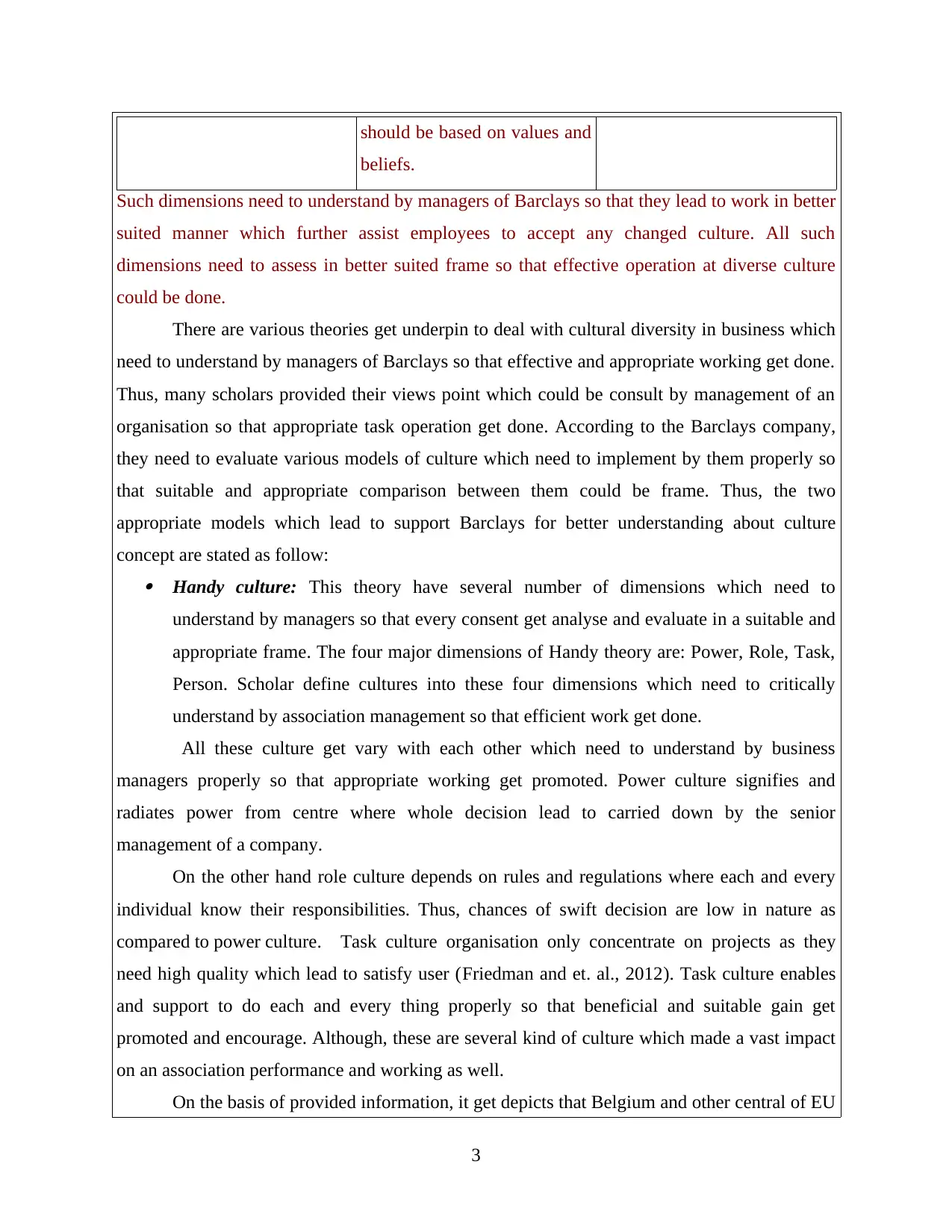
should be based on values and
beliefs.
Such dimensions need to understand by managers of Barclays so that they lead to work in better
suited manner which further assist employees to accept any changed culture. All such
dimensions need to assess in better suited frame so that effective operation at diverse culture
could be done.
There are various theories get underpin to deal with cultural diversity in business which
need to understand by managers of Barclays so that effective and appropriate working get done.
Thus, many scholars provided their views point which could be consult by management of an
organisation so that appropriate task operation get done. According to the Barclays company,
they need to evaluate various models of culture which need to implement by them properly so
that suitable and appropriate comparison between them could be frame. Thus, the two
appropriate models which lead to support Barclays for better understanding about culture
concept are stated as follow: Handy culture: This theory have several number of dimensions which need to
understand by managers so that every consent get analyse and evaluate in a suitable and
appropriate frame. The four major dimensions of Handy theory are: Power, Role, Task,
Person. Scholar define cultures into these four dimensions which need to critically
understand by association management so that efficient work get done.
All these culture get vary with each other which need to understand by business
managers properly so that appropriate working get promoted. Power culture signifies and
radiates power from centre where whole decision lead to carried down by the senior
management of a company.
On the other hand role culture depends on rules and regulations where each and every
individual know their responsibilities. Thus, chances of swift decision are low in nature as
compared to power culture. Task culture organisation only concentrate on projects as they
need high quality which lead to satisfy user (Friedman and et. al., 2012). Task culture enables
and support to do each and every thing properly so that beneficial and suitable gain get
promoted and encourage. Although, these are several kind of culture which made a vast impact
on an association performance and working as well.
On the basis of provided information, it get depicts that Belgium and other central of EU
3
beliefs.
Such dimensions need to understand by managers of Barclays so that they lead to work in better
suited manner which further assist employees to accept any changed culture. All such
dimensions need to assess in better suited frame so that effective operation at diverse culture
could be done.
There are various theories get underpin to deal with cultural diversity in business which
need to understand by managers of Barclays so that effective and appropriate working get done.
Thus, many scholars provided their views point which could be consult by management of an
organisation so that appropriate task operation get done. According to the Barclays company,
they need to evaluate various models of culture which need to implement by them properly so
that suitable and appropriate comparison between them could be frame. Thus, the two
appropriate models which lead to support Barclays for better understanding about culture
concept are stated as follow: Handy culture: This theory have several number of dimensions which need to
understand by managers so that every consent get analyse and evaluate in a suitable and
appropriate frame. The four major dimensions of Handy theory are: Power, Role, Task,
Person. Scholar define cultures into these four dimensions which need to critically
understand by association management so that efficient work get done.
All these culture get vary with each other which need to understand by business
managers properly so that appropriate working get promoted. Power culture signifies and
radiates power from centre where whole decision lead to carried down by the senior
management of a company.
On the other hand role culture depends on rules and regulations where each and every
individual know their responsibilities. Thus, chances of swift decision are low in nature as
compared to power culture. Task culture organisation only concentrate on projects as they
need high quality which lead to satisfy user (Friedman and et. al., 2012). Task culture enables
and support to do each and every thing properly so that beneficial and suitable gain get
promoted and encourage. Although, these are several kind of culture which made a vast impact
on an association performance and working as well.
On the basis of provided information, it get depicts that Belgium and other central of EU
3
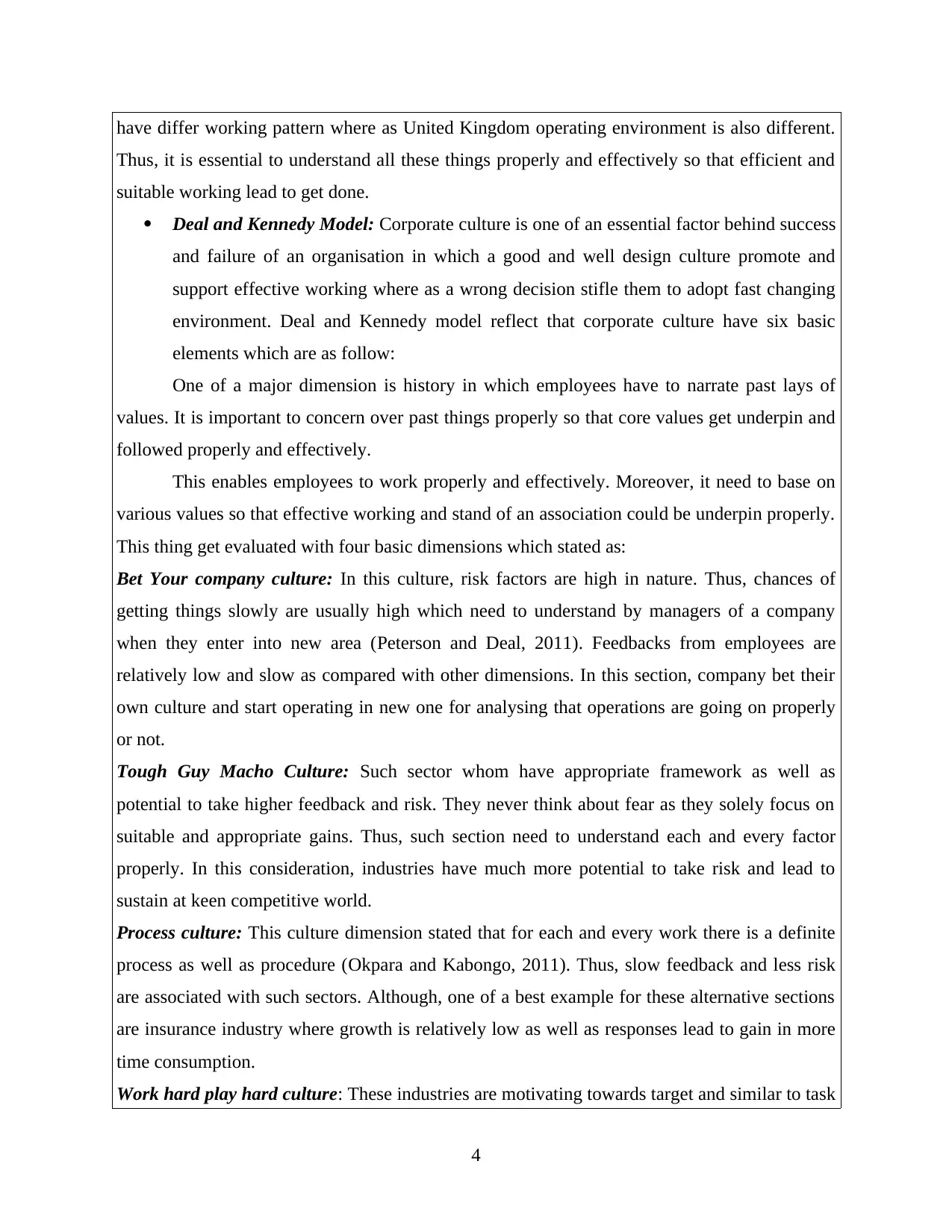
have differ working pattern where as United Kingdom operating environment is also different.
Thus, it is essential to understand all these things properly and effectively so that efficient and
suitable working lead to get done.
Deal and Kennedy Model: Corporate culture is one of an essential factor behind success
and failure of an organisation in which a good and well design culture promote and
support effective working where as a wrong decision stifle them to adopt fast changing
environment. Deal and Kennedy model reflect that corporate culture have six basic
elements which are as follow:
One of a major dimension is history in which employees have to narrate past lays of
values. It is important to concern over past things properly so that core values get underpin and
followed properly and effectively.
This enables employees to work properly and effectively. Moreover, it need to base on
various values so that effective working and stand of an association could be underpin properly.
This thing get evaluated with four basic dimensions which stated as:
Bet Your company culture: In this culture, risk factors are high in nature. Thus, chances of
getting things slowly are usually high which need to understand by managers of a company
when they enter into new area (Peterson and Deal, 2011). Feedbacks from employees are
relatively low and slow as compared with other dimensions. In this section, company bet their
own culture and start operating in new one for analysing that operations are going on properly
or not.
Tough Guy Macho Culture: Such sector whom have appropriate framework as well as
potential to take higher feedback and risk. They never think about fear as they solely focus on
suitable and appropriate gains. Thus, such section need to understand each and every factor
properly. In this consideration, industries have much more potential to take risk and lead to
sustain at keen competitive world.
Process culture: This culture dimension stated that for each and every work there is a definite
process as well as procedure (Okpara and Kabongo, 2011). Thus, slow feedback and less risk
are associated with such sectors. Although, one of a best example for these alternative sections
are insurance industry where growth is relatively low as well as responses lead to gain in more
time consumption.
Work hard play hard culture: These industries are motivating towards target and similar to task
4
Thus, it is essential to understand all these things properly and effectively so that efficient and
suitable working lead to get done.
Deal and Kennedy Model: Corporate culture is one of an essential factor behind success
and failure of an organisation in which a good and well design culture promote and
support effective working where as a wrong decision stifle them to adopt fast changing
environment. Deal and Kennedy model reflect that corporate culture have six basic
elements which are as follow:
One of a major dimension is history in which employees have to narrate past lays of
values. It is important to concern over past things properly so that core values get underpin and
followed properly and effectively.
This enables employees to work properly and effectively. Moreover, it need to base on
various values so that effective working and stand of an association could be underpin properly.
This thing get evaluated with four basic dimensions which stated as:
Bet Your company culture: In this culture, risk factors are high in nature. Thus, chances of
getting things slowly are usually high which need to understand by managers of a company
when they enter into new area (Peterson and Deal, 2011). Feedbacks from employees are
relatively low and slow as compared with other dimensions. In this section, company bet their
own culture and start operating in new one for analysing that operations are going on properly
or not.
Tough Guy Macho Culture: Such sector whom have appropriate framework as well as
potential to take higher feedback and risk. They never think about fear as they solely focus on
suitable and appropriate gains. Thus, such section need to understand each and every factor
properly. In this consideration, industries have much more potential to take risk and lead to
sustain at keen competitive world.
Process culture: This culture dimension stated that for each and every work there is a definite
process as well as procedure (Okpara and Kabongo, 2011). Thus, slow feedback and less risk
are associated with such sectors. Although, one of a best example for these alternative sections
are insurance industry where growth is relatively low as well as responses lead to gain in more
time consumption.
Work hard play hard culture: These industries are motivating towards target and similar to task
4
⊘ This is a preview!⊘
Do you want full access?
Subscribe today to unlock all pages.

Trusted by 1+ million students worldwide
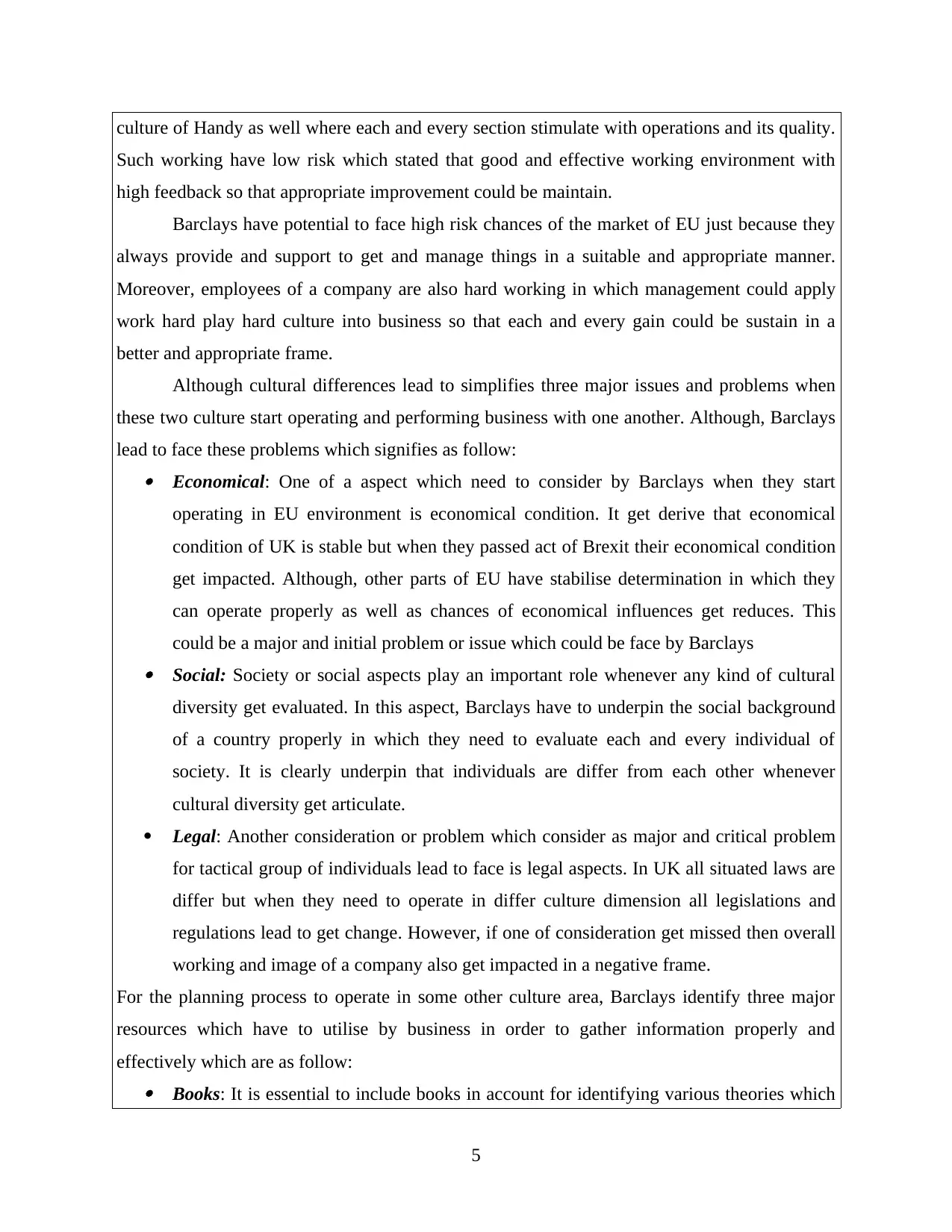
culture of Handy as well where each and every section stimulate with operations and its quality.
Such working have low risk which stated that good and effective working environment with
high feedback so that appropriate improvement could be maintain.
Barclays have potential to face high risk chances of the market of EU just because they
always provide and support to get and manage things in a suitable and appropriate manner.
Moreover, employees of a company are also hard working in which management could apply
work hard play hard culture into business so that each and every gain could be sustain in a
better and appropriate frame.
Although cultural differences lead to simplifies three major issues and problems when
these two culture start operating and performing business with one another. Although, Barclays
lead to face these problems which signifies as follow: Economical: One of a aspect which need to consider by Barclays when they start
operating in EU environment is economical condition. It get derive that economical
condition of UK is stable but when they passed act of Brexit their economical condition
get impacted. Although, other parts of EU have stabilise determination in which they
can operate properly as well as chances of economical influences get reduces. This
could be a major and initial problem or issue which could be face by Barclays Social: Society or social aspects play an important role whenever any kind of cultural
diversity get evaluated. In this aspect, Barclays have to underpin the social background
of a country properly in which they need to evaluate each and every individual of
society. It is clearly underpin that individuals are differ from each other whenever
cultural diversity get articulate.
Legal: Another consideration or problem which consider as major and critical problem
for tactical group of individuals lead to face is legal aspects. In UK all situated laws are
differ but when they need to operate in differ culture dimension all legislations and
regulations lead to get change. However, if one of consideration get missed then overall
working and image of a company also get impacted in a negative frame.
For the planning process to operate in some other culture area, Barclays identify three major
resources which have to utilise by business in order to gather information properly and
effectively which are as follow: Books: It is essential to include books in account for identifying various theories which
5
Such working have low risk which stated that good and effective working environment with
high feedback so that appropriate improvement could be maintain.
Barclays have potential to face high risk chances of the market of EU just because they
always provide and support to get and manage things in a suitable and appropriate manner.
Moreover, employees of a company are also hard working in which management could apply
work hard play hard culture into business so that each and every gain could be sustain in a
better and appropriate frame.
Although cultural differences lead to simplifies three major issues and problems when
these two culture start operating and performing business with one another. Although, Barclays
lead to face these problems which signifies as follow: Economical: One of a aspect which need to consider by Barclays when they start
operating in EU environment is economical condition. It get derive that economical
condition of UK is stable but when they passed act of Brexit their economical condition
get impacted. Although, other parts of EU have stabilise determination in which they
can operate properly as well as chances of economical influences get reduces. This
could be a major and initial problem or issue which could be face by Barclays Social: Society or social aspects play an important role whenever any kind of cultural
diversity get evaluated. In this aspect, Barclays have to underpin the social background
of a country properly in which they need to evaluate each and every individual of
society. It is clearly underpin that individuals are differ from each other whenever
cultural diversity get articulate.
Legal: Another consideration or problem which consider as major and critical problem
for tactical group of individuals lead to face is legal aspects. In UK all situated laws are
differ but when they need to operate in differ culture dimension all legislations and
regulations lead to get change. However, if one of consideration get missed then overall
working and image of a company also get impacted in a negative frame.
For the planning process to operate in some other culture area, Barclays identify three major
resources which have to utilise by business in order to gather information properly and
effectively which are as follow: Books: It is essential to include books in account for identifying various theories which
5
Paraphrase This Document
Need a fresh take? Get an instant paraphrase of this document with our AI Paraphraser
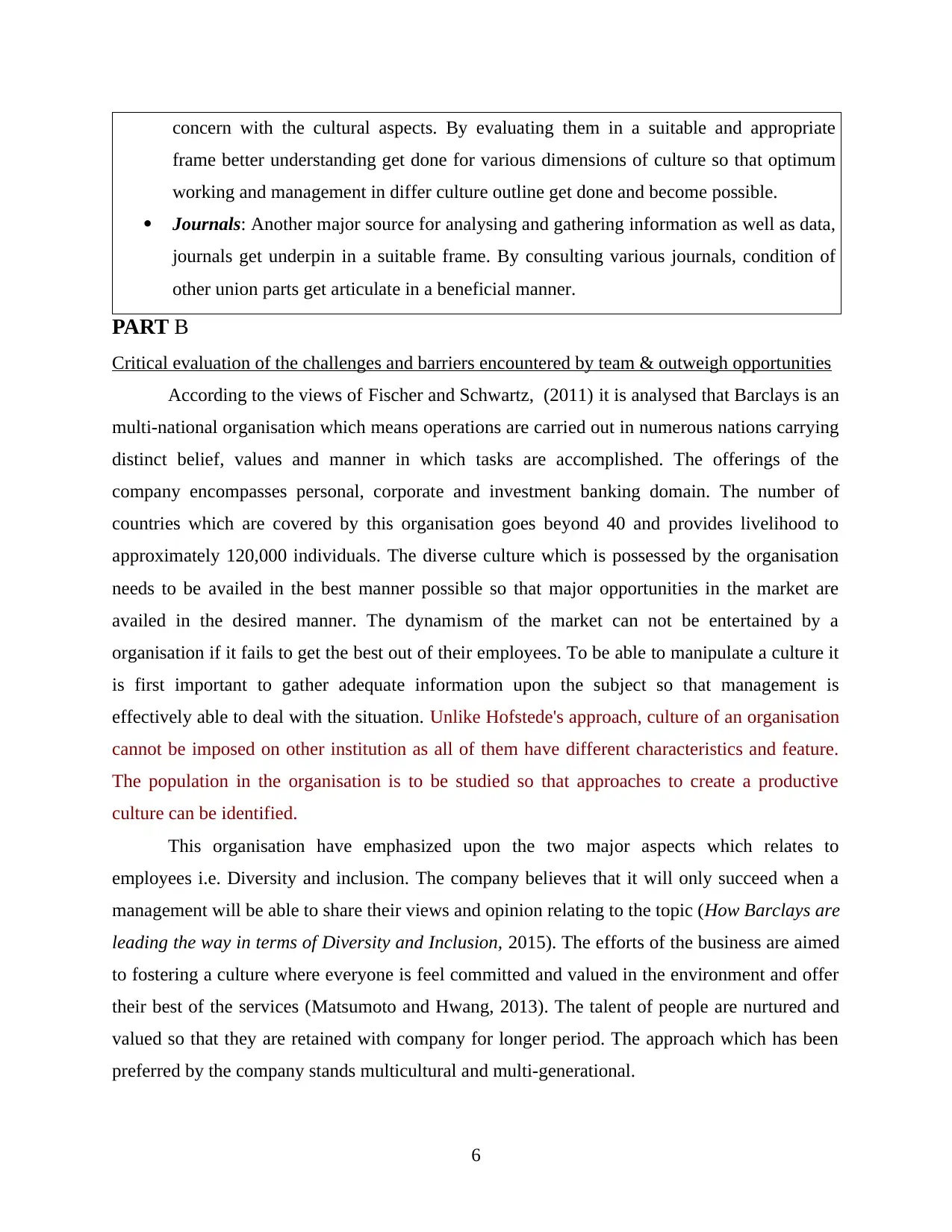
concern with the cultural aspects. By evaluating them in a suitable and appropriate
frame better understanding get done for various dimensions of culture so that optimum
working and management in differ culture outline get done and become possible.
Journals: Another major source for analysing and gathering information as well as data,
journals get underpin in a suitable frame. By consulting various journals, condition of
other union parts get articulate in a beneficial manner.
PART B
Critical evaluation of the challenges and barriers encountered by team & outweigh opportunities
According to the views of Fischer and Schwartz, (2011) it is analysed that Barclays is an
multi-national organisation which means operations are carried out in numerous nations carrying
distinct belief, values and manner in which tasks are accomplished. The offerings of the
company encompasses personal, corporate and investment banking domain. The number of
countries which are covered by this organisation goes beyond 40 and provides livelihood to
approximately 120,000 individuals. The diverse culture which is possessed by the organisation
needs to be availed in the best manner possible so that major opportunities in the market are
availed in the desired manner. The dynamism of the market can not be entertained by a
organisation if it fails to get the best out of their employees. To be able to manipulate a culture it
is first important to gather adequate information upon the subject so that management is
effectively able to deal with the situation. Unlike Hofstede's approach, culture of an organisation
cannot be imposed on other institution as all of them have different characteristics and feature.
The population in the organisation is to be studied so that approaches to create a productive
culture can be identified.
This organisation have emphasized upon the two major aspects which relates to
employees i.e. Diversity and inclusion. The company believes that it will only succeed when a
management will be able to share their views and opinion relating to the topic (How Barclays are
leading the way in terms of Diversity and Inclusion, 2015). The efforts of the business are aimed
to fostering a culture where everyone is feel committed and valued in the environment and offer
their best of the services (Matsumoto and Hwang, 2013). The talent of people are nurtured and
valued so that they are retained with company for longer period. The approach which has been
preferred by the company stands multicultural and multi-generational.
6
frame better understanding get done for various dimensions of culture so that optimum
working and management in differ culture outline get done and become possible.
Journals: Another major source for analysing and gathering information as well as data,
journals get underpin in a suitable frame. By consulting various journals, condition of
other union parts get articulate in a beneficial manner.
PART B
Critical evaluation of the challenges and barriers encountered by team & outweigh opportunities
According to the views of Fischer and Schwartz, (2011) it is analysed that Barclays is an
multi-national organisation which means operations are carried out in numerous nations carrying
distinct belief, values and manner in which tasks are accomplished. The offerings of the
company encompasses personal, corporate and investment banking domain. The number of
countries which are covered by this organisation goes beyond 40 and provides livelihood to
approximately 120,000 individuals. The diverse culture which is possessed by the organisation
needs to be availed in the best manner possible so that major opportunities in the market are
availed in the desired manner. The dynamism of the market can not be entertained by a
organisation if it fails to get the best out of their employees. To be able to manipulate a culture it
is first important to gather adequate information upon the subject so that management is
effectively able to deal with the situation. Unlike Hofstede's approach, culture of an organisation
cannot be imposed on other institution as all of them have different characteristics and feature.
The population in the organisation is to be studied so that approaches to create a productive
culture can be identified.
This organisation have emphasized upon the two major aspects which relates to
employees i.e. Diversity and inclusion. The company believes that it will only succeed when a
management will be able to share their views and opinion relating to the topic (How Barclays are
leading the way in terms of Diversity and Inclusion, 2015). The efforts of the business are aimed
to fostering a culture where everyone is feel committed and valued in the environment and offer
their best of the services (Matsumoto and Hwang, 2013). The talent of people are nurtured and
valued so that they are retained with company for longer period. The approach which has been
preferred by the company stands multicultural and multi-generational.
6
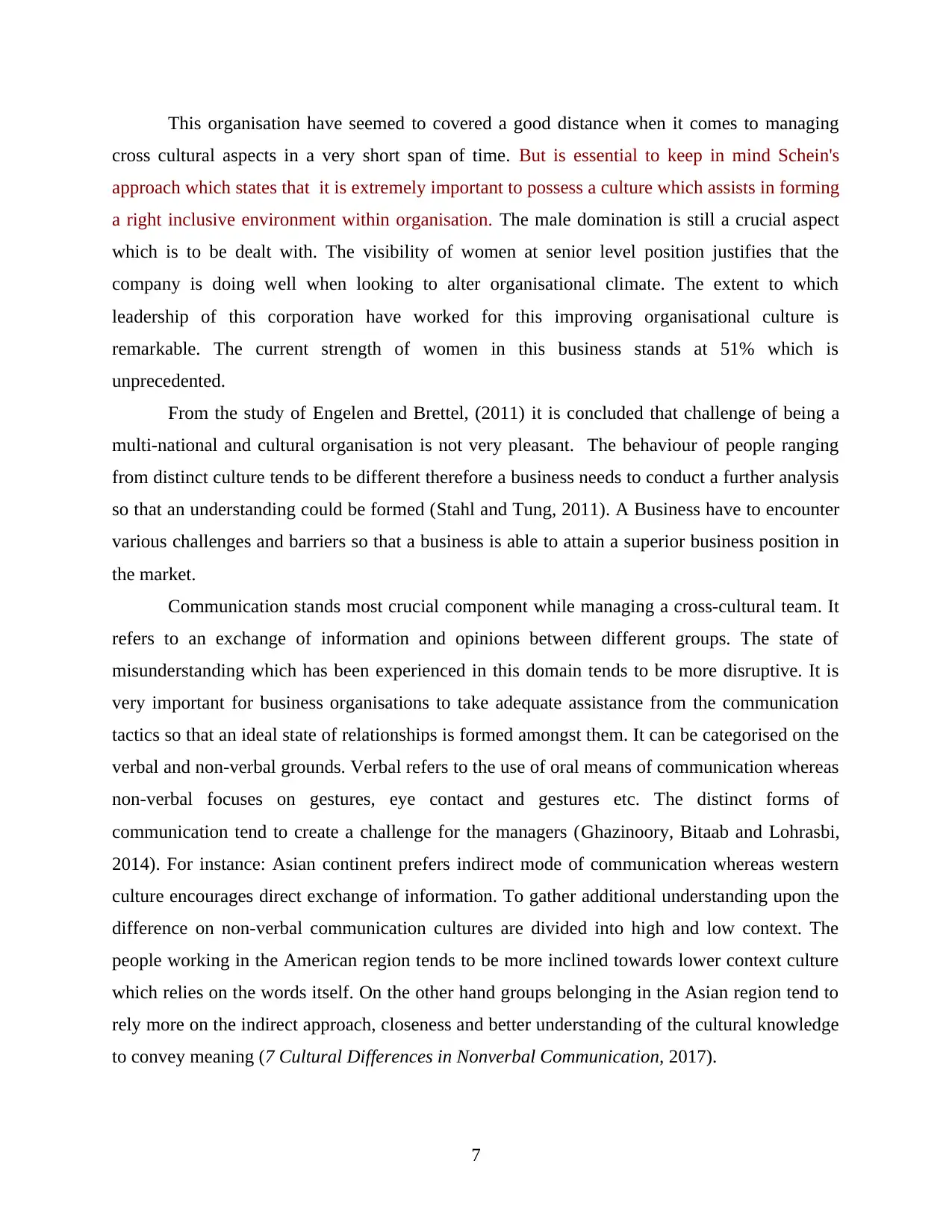
This organisation have seemed to covered a good distance when it comes to managing
cross cultural aspects in a very short span of time. But is essential to keep in mind Schein's
approach which states that it is extremely important to possess a culture which assists in forming
a right inclusive environment within organisation. The male domination is still a crucial aspect
which is to be dealt with. The visibility of women at senior level position justifies that the
company is doing well when looking to alter organisational climate. The extent to which
leadership of this corporation have worked for this improving organisational culture is
remarkable. The current strength of women in this business stands at 51% which is
unprecedented.
From the study of Engelen and Brettel, (2011) it is concluded that challenge of being a
multi-national and cultural organisation is not very pleasant. The behaviour of people ranging
from distinct culture tends to be different therefore a business needs to conduct a further analysis
so that an understanding could be formed (Stahl and Tung, 2011). A Business have to encounter
various challenges and barriers so that a business is able to attain a superior business position in
the market.
Communication stands most crucial component while managing a cross-cultural team. It
refers to an exchange of information and opinions between different groups. The state of
misunderstanding which has been experienced in this domain tends to be more disruptive. It is
very important for business organisations to take adequate assistance from the communication
tactics so that an ideal state of relationships is formed amongst them. It can be categorised on the
verbal and non-verbal grounds. Verbal refers to the use of oral means of communication whereas
non-verbal focuses on gestures, eye contact and gestures etc. The distinct forms of
communication tend to create a challenge for the managers (Ghazinoory, Bitaab and Lohrasbi,
2014). For instance: Asian continent prefers indirect mode of communication whereas western
culture encourages direct exchange of information. To gather additional understanding upon the
difference on non-verbal communication cultures are divided into high and low context. The
people working in the American region tends to be more inclined towards lower context culture
which relies on the words itself. On the other hand groups belonging in the Asian region tend to
rely more on the indirect approach, closeness and better understanding of the cultural knowledge
to convey meaning (7 Cultural Differences in Nonverbal Communication, 2017).
7
cross cultural aspects in a very short span of time. But is essential to keep in mind Schein's
approach which states that it is extremely important to possess a culture which assists in forming
a right inclusive environment within organisation. The male domination is still a crucial aspect
which is to be dealt with. The visibility of women at senior level position justifies that the
company is doing well when looking to alter organisational climate. The extent to which
leadership of this corporation have worked for this improving organisational culture is
remarkable. The current strength of women in this business stands at 51% which is
unprecedented.
From the study of Engelen and Brettel, (2011) it is concluded that challenge of being a
multi-national and cultural organisation is not very pleasant. The behaviour of people ranging
from distinct culture tends to be different therefore a business needs to conduct a further analysis
so that an understanding could be formed (Stahl and Tung, 2011). A Business have to encounter
various challenges and barriers so that a business is able to attain a superior business position in
the market.
Communication stands most crucial component while managing a cross-cultural team. It
refers to an exchange of information and opinions between different groups. The state of
misunderstanding which has been experienced in this domain tends to be more disruptive. It is
very important for business organisations to take adequate assistance from the communication
tactics so that an ideal state of relationships is formed amongst them. It can be categorised on the
verbal and non-verbal grounds. Verbal refers to the use of oral means of communication whereas
non-verbal focuses on gestures, eye contact and gestures etc. The distinct forms of
communication tend to create a challenge for the managers (Ghazinoory, Bitaab and Lohrasbi,
2014). For instance: Asian continent prefers indirect mode of communication whereas western
culture encourages direct exchange of information. To gather additional understanding upon the
difference on non-verbal communication cultures are divided into high and low context. The
people working in the American region tends to be more inclined towards lower context culture
which relies on the words itself. On the other hand groups belonging in the Asian region tend to
rely more on the indirect approach, closeness and better understanding of the cultural knowledge
to convey meaning (7 Cultural Differences in Nonverbal Communication, 2017).
7
⊘ This is a preview!⊘
Do you want full access?
Subscribe today to unlock all pages.

Trusted by 1+ million students worldwide
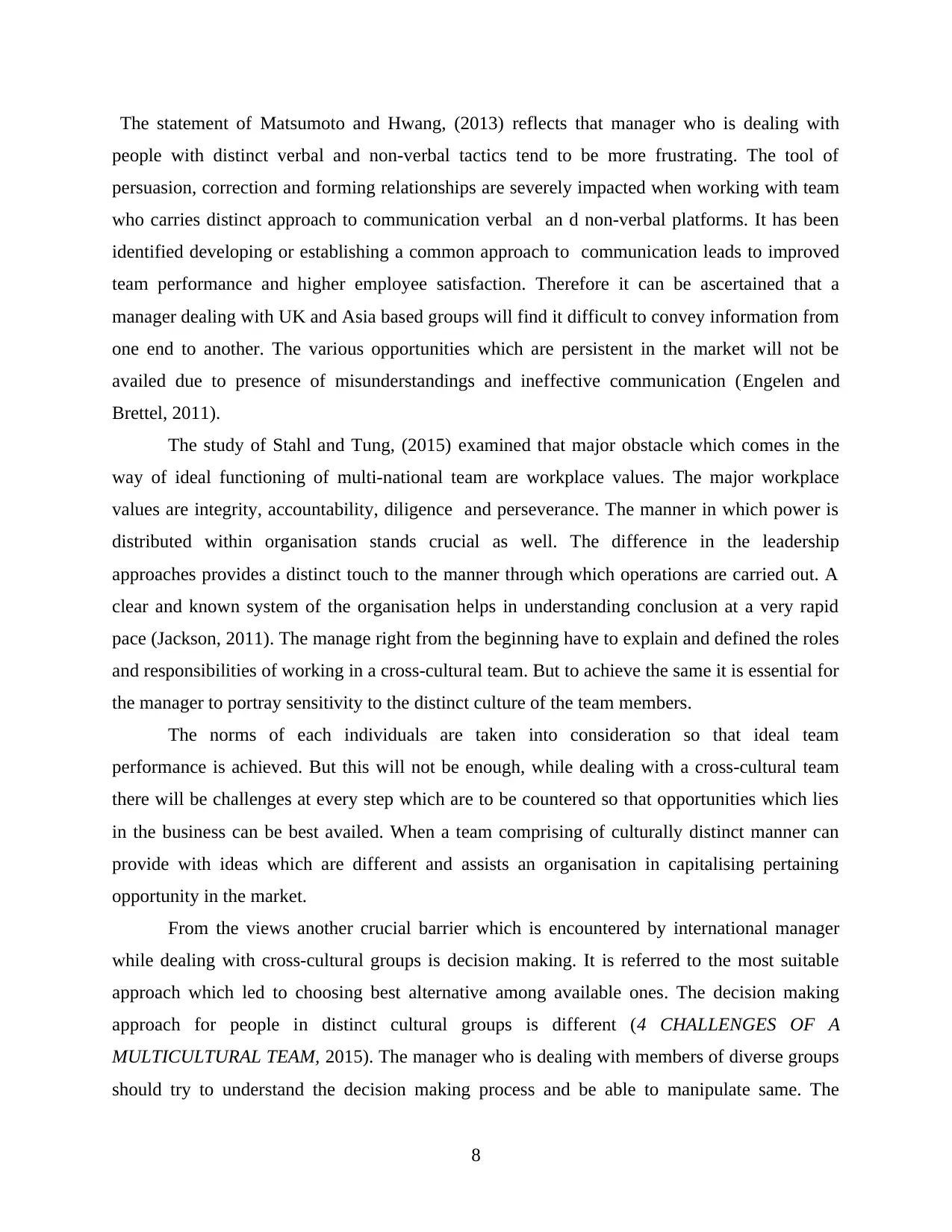
The statement of Matsumoto and Hwang, (2013) reflects that manager who is dealing with
people with distinct verbal and non-verbal tactics tend to be more frustrating. The tool of
persuasion, correction and forming relationships are severely impacted when working with team
who carries distinct approach to communication verbal an d non-verbal platforms. It has been
identified developing or establishing a common approach to communication leads to improved
team performance and higher employee satisfaction. Therefore it can be ascertained that a
manager dealing with UK and Asia based groups will find it difficult to convey information from
one end to another. The various opportunities which are persistent in the market will not be
availed due to presence of misunderstandings and ineffective communication (Engelen and
Brettel, 2011).
The study of Stahl and Tung, (2015) examined that major obstacle which comes in the
way of ideal functioning of multi-national team are workplace values. The major workplace
values are integrity, accountability, diligence and perseverance. The manner in which power is
distributed within organisation stands crucial as well. The difference in the leadership
approaches provides a distinct touch to the manner through which operations are carried out. A
clear and known system of the organisation helps in understanding conclusion at a very rapid
pace (Jackson, 2011). The manage right from the beginning have to explain and defined the roles
and responsibilities of working in a cross-cultural team. But to achieve the same it is essential for
the manager to portray sensitivity to the distinct culture of the team members.
The norms of each individuals are taken into consideration so that ideal team
performance is achieved. But this will not be enough, while dealing with a cross-cultural team
there will be challenges at every step which are to be countered so that opportunities which lies
in the business can be best availed. When a team comprising of culturally distinct manner can
provide with ideas which are different and assists an organisation in capitalising pertaining
opportunity in the market.
From the views another crucial barrier which is encountered by international manager
while dealing with cross-cultural groups is decision making. It is referred to the most suitable
approach which led to choosing best alternative among available ones. The decision making
approach for people in distinct cultural groups is different (4 CHALLENGES OF A
MULTICULTURAL TEAM, 2015). The manager who is dealing with members of diverse groups
should try to understand the decision making process and be able to manipulate same. The
8
people with distinct verbal and non-verbal tactics tend to be more frustrating. The tool of
persuasion, correction and forming relationships are severely impacted when working with team
who carries distinct approach to communication verbal an d non-verbal platforms. It has been
identified developing or establishing a common approach to communication leads to improved
team performance and higher employee satisfaction. Therefore it can be ascertained that a
manager dealing with UK and Asia based groups will find it difficult to convey information from
one end to another. The various opportunities which are persistent in the market will not be
availed due to presence of misunderstandings and ineffective communication (Engelen and
Brettel, 2011).
The study of Stahl and Tung, (2015) examined that major obstacle which comes in the
way of ideal functioning of multi-national team are workplace values. The major workplace
values are integrity, accountability, diligence and perseverance. The manner in which power is
distributed within organisation stands crucial as well. The difference in the leadership
approaches provides a distinct touch to the manner through which operations are carried out. A
clear and known system of the organisation helps in understanding conclusion at a very rapid
pace (Jackson, 2011). The manage right from the beginning have to explain and defined the roles
and responsibilities of working in a cross-cultural team. But to achieve the same it is essential for
the manager to portray sensitivity to the distinct culture of the team members.
The norms of each individuals are taken into consideration so that ideal team
performance is achieved. But this will not be enough, while dealing with a cross-cultural team
there will be challenges at every step which are to be countered so that opportunities which lies
in the business can be best availed. When a team comprising of culturally distinct manner can
provide with ideas which are different and assists an organisation in capitalising pertaining
opportunity in the market.
From the views another crucial barrier which is encountered by international manager
while dealing with cross-cultural groups is decision making. It is referred to the most suitable
approach which led to choosing best alternative among available ones. The decision making
approach for people in distinct cultural groups is different (4 CHALLENGES OF A
MULTICULTURAL TEAM, 2015). The manager who is dealing with members of diverse groups
should try to understand the decision making process and be able to manipulate same. The
8
Paraphrase This Document
Need a fresh take? Get an instant paraphrase of this document with our AI Paraphraser
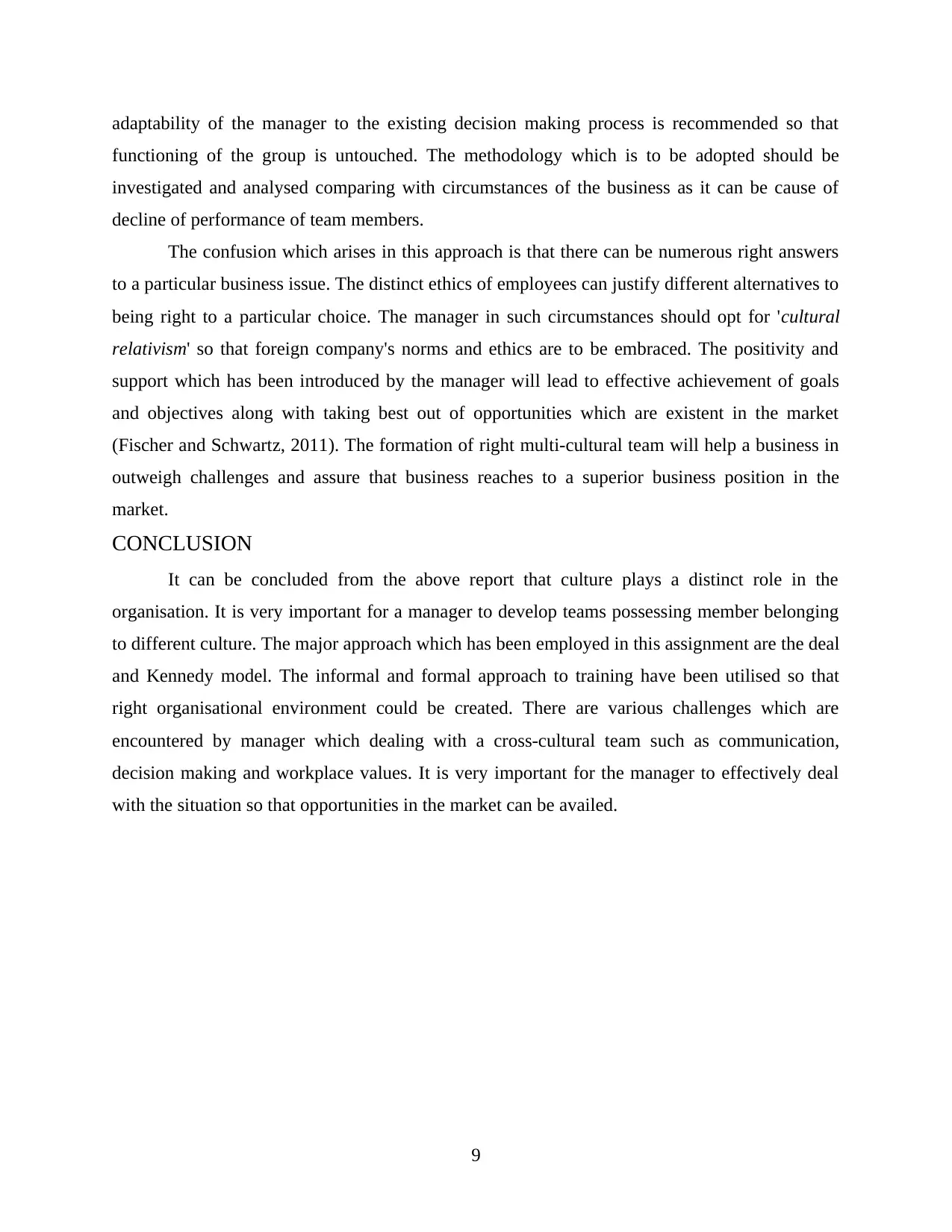
adaptability of the manager to the existing decision making process is recommended so that
functioning of the group is untouched. The methodology which is to be adopted should be
investigated and analysed comparing with circumstances of the business as it can be cause of
decline of performance of team members.
The confusion which arises in this approach is that there can be numerous right answers
to a particular business issue. The distinct ethics of employees can justify different alternatives to
being right to a particular choice. The manager in such circumstances should opt for 'cultural
relativism' so that foreign company's norms and ethics are to be embraced. The positivity and
support which has been introduced by the manager will lead to effective achievement of goals
and objectives along with taking best out of opportunities which are existent in the market
(Fischer and Schwartz, 2011). The formation of right multi-cultural team will help a business in
outweigh challenges and assure that business reaches to a superior business position in the
market.
CONCLUSION
It can be concluded from the above report that culture plays a distinct role in the
organisation. It is very important for a manager to develop teams possessing member belonging
to different culture. The major approach which has been employed in this assignment are the deal
and Kennedy model. The informal and formal approach to training have been utilised so that
right organisational environment could be created. There are various challenges which are
encountered by manager which dealing with a cross-cultural team such as communication,
decision making and workplace values. It is very important for the manager to effectively deal
with the situation so that opportunities in the market can be availed.
9
functioning of the group is untouched. The methodology which is to be adopted should be
investigated and analysed comparing with circumstances of the business as it can be cause of
decline of performance of team members.
The confusion which arises in this approach is that there can be numerous right answers
to a particular business issue. The distinct ethics of employees can justify different alternatives to
being right to a particular choice. The manager in such circumstances should opt for 'cultural
relativism' so that foreign company's norms and ethics are to be embraced. The positivity and
support which has been introduced by the manager will lead to effective achievement of goals
and objectives along with taking best out of opportunities which are existent in the market
(Fischer and Schwartz, 2011). The formation of right multi-cultural team will help a business in
outweigh challenges and assure that business reaches to a superior business position in the
market.
CONCLUSION
It can be concluded from the above report that culture plays a distinct role in the
organisation. It is very important for a manager to develop teams possessing member belonging
to different culture. The major approach which has been employed in this assignment are the deal
and Kennedy model. The informal and formal approach to training have been utilised so that
right organisational environment could be created. There are various challenges which are
encountered by manager which dealing with a cross-cultural team such as communication,
decision making and workplace values. It is very important for the manager to effectively deal
with the situation so that opportunities in the market can be availed.
9
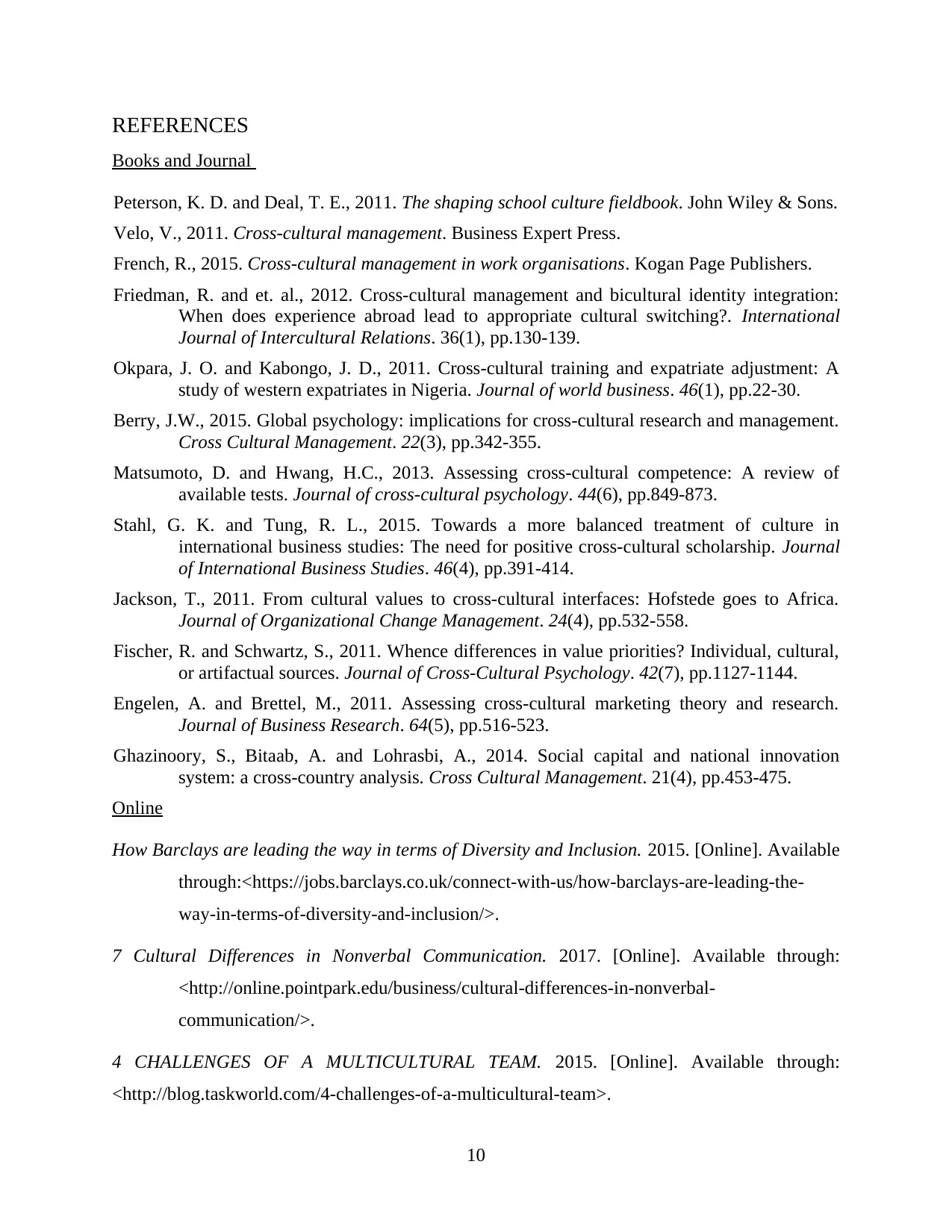
REFERENCES
Books and Journal
Peterson, K. D. and Deal, T. E., 2011. The shaping school culture fieldbook. John Wiley & Sons.
Velo, V., 2011. Cross-cultural management. Business Expert Press.
French, R., 2015. Cross-cultural management in work organisations. Kogan Page Publishers.
Friedman, R. and et. al., 2012. Cross-cultural management and bicultural identity integration:
When does experience abroad lead to appropriate cultural switching?. International
Journal of Intercultural Relations. 36(1), pp.130-139.
Okpara, J. O. and Kabongo, J. D., 2011. Cross-cultural training and expatriate adjustment: A
study of western expatriates in Nigeria. Journal of world business. 46(1), pp.22-30.
Berry, J.W., 2015. Global psychology: implications for cross-cultural research and management.
Cross Cultural Management. 22(3), pp.342-355.
Matsumoto, D. and Hwang, H.C., 2013. Assessing cross-cultural competence: A review of
available tests. Journal of cross-cultural psychology. 44(6), pp.849-873.
Stahl, G. K. and Tung, R. L., 2015. Towards a more balanced treatment of culture in
international business studies: The need for positive cross-cultural scholarship. Journal
of International Business Studies. 46(4), pp.391-414.
Jackson, T., 2011. From cultural values to cross-cultural interfaces: Hofstede goes to Africa.
Journal of Organizational Change Management. 24(4), pp.532-558.
Fischer, R. and Schwartz, S., 2011. Whence differences in value priorities? Individual, cultural,
or artifactual sources. Journal of Cross-Cultural Psychology. 42(7), pp.1127-1144.
Engelen, A. and Brettel, M., 2011. Assessing cross-cultural marketing theory and research.
Journal of Business Research. 64(5), pp.516-523.
Ghazinoory, S., Bitaab, A. and Lohrasbi, A., 2014. Social capital and national innovation
system: a cross-country analysis. Cross Cultural Management. 21(4), pp.453-475.
Online
How Barclays are leading the way in terms of Diversity and Inclusion. 2015. [Online]. Available
through:<https://jobs.barclays.co.uk/connect-with-us/how-barclays-are-leading-the-
way-in-terms-of-diversity-and-inclusion/>.
7 Cultural Differences in Nonverbal Communication. 2017. [Online]. Available through:
<http://online.pointpark.edu/business/cultural-differences-in-nonverbal-
communication/>.
4 CHALLENGES OF A MULTICULTURAL TEAM. 2015. [Online]. Available through:
<http://blog.taskworld.com/4-challenges-of-a-multicultural-team>.
10
Books and Journal
Peterson, K. D. and Deal, T. E., 2011. The shaping school culture fieldbook. John Wiley & Sons.
Velo, V., 2011. Cross-cultural management. Business Expert Press.
French, R., 2015. Cross-cultural management in work organisations. Kogan Page Publishers.
Friedman, R. and et. al., 2012. Cross-cultural management and bicultural identity integration:
When does experience abroad lead to appropriate cultural switching?. International
Journal of Intercultural Relations. 36(1), pp.130-139.
Okpara, J. O. and Kabongo, J. D., 2011. Cross-cultural training and expatriate adjustment: A
study of western expatriates in Nigeria. Journal of world business. 46(1), pp.22-30.
Berry, J.W., 2015. Global psychology: implications for cross-cultural research and management.
Cross Cultural Management. 22(3), pp.342-355.
Matsumoto, D. and Hwang, H.C., 2013. Assessing cross-cultural competence: A review of
available tests. Journal of cross-cultural psychology. 44(6), pp.849-873.
Stahl, G. K. and Tung, R. L., 2015. Towards a more balanced treatment of culture in
international business studies: The need for positive cross-cultural scholarship. Journal
of International Business Studies. 46(4), pp.391-414.
Jackson, T., 2011. From cultural values to cross-cultural interfaces: Hofstede goes to Africa.
Journal of Organizational Change Management. 24(4), pp.532-558.
Fischer, R. and Schwartz, S., 2011. Whence differences in value priorities? Individual, cultural,
or artifactual sources. Journal of Cross-Cultural Psychology. 42(7), pp.1127-1144.
Engelen, A. and Brettel, M., 2011. Assessing cross-cultural marketing theory and research.
Journal of Business Research. 64(5), pp.516-523.
Ghazinoory, S., Bitaab, A. and Lohrasbi, A., 2014. Social capital and national innovation
system: a cross-country analysis. Cross Cultural Management. 21(4), pp.453-475.
Online
How Barclays are leading the way in terms of Diversity and Inclusion. 2015. [Online]. Available
through:<https://jobs.barclays.co.uk/connect-with-us/how-barclays-are-leading-the-
way-in-terms-of-diversity-and-inclusion/>.
7 Cultural Differences in Nonverbal Communication. 2017. [Online]. Available through:
<http://online.pointpark.edu/business/cultural-differences-in-nonverbal-
communication/>.
4 CHALLENGES OF A MULTICULTURAL TEAM. 2015. [Online]. Available through:
<http://blog.taskworld.com/4-challenges-of-a-multicultural-team>.
10
⊘ This is a preview!⊘
Do you want full access?
Subscribe today to unlock all pages.

Trusted by 1+ million students worldwide
1 out of 13
Related Documents
Your All-in-One AI-Powered Toolkit for Academic Success.
+13062052269
info@desklib.com
Available 24*7 on WhatsApp / Email
![[object Object]](/_next/static/media/star-bottom.7253800d.svg)
Unlock your academic potential
Copyright © 2020–2025 A2Z Services. All Rights Reserved. Developed and managed by ZUCOL.





